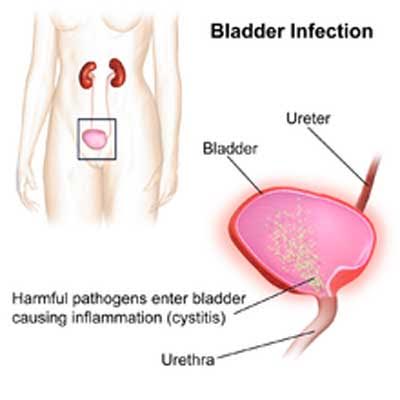- Home
- Editorial
- News
- Practice Guidelines
- Anesthesiology Guidelines
- Cancer Guidelines
- Cardiac Sciences Guidelines
- Critical Care Guidelines
- Dentistry Guidelines
- Dermatology Guidelines
- Diabetes and Endo Guidelines
- Diagnostics Guidelines
- ENT Guidelines
- Featured Practice Guidelines
- Gastroenterology Guidelines
- Geriatrics Guidelines
- Medicine Guidelines
- Nephrology Guidelines
- Neurosciences Guidelines
- Obs and Gynae Guidelines
- Ophthalmology Guidelines
- Orthopaedics Guidelines
- Paediatrics Guidelines
- Psychiatry Guidelines
- Pulmonology Guidelines
- Radiology Guidelines
- Surgery Guidelines
- Urology Guidelines
Researchers take a new step towards non-antibiotic bladder infection therapies

Cystitis is a common infection, particularly in women. Although usually treatable with antibiotics, patients can be plagued with recurrent and chronic infections. When ascending to the kidneys, bladder infections can turn into a life threatening compli...
A cross-border team of scientists has gained fresh insight into the development of bladder infections, also known as cystitis. These findings are the result of a close collaboration between Belgian researchers from VIB Vrije Universiteit Brussel (VUB) in Brussels and their American colleagues at the center for Women's Infectious Disease Research (cWIDR) at Washington University in St. Louis. Escherichia coli the main bacterial cause behind cystitis turns out to use two complementary types of hair-like structures or pili to adhere to bladder cells, depending on whether the infection is in its early stage or a later phase. This discovery, published in the leading scientific journal Cell Host & Microbe, may be crucial to the development of new non-antibiotic therapies to treat the later stages of infection.
Cystitis is a common infection, particularly in women. Although usually treatable with antibiotics, patients can be plagued with recurrent and chronic infections. When ascending to the kidneys, bladder infections can turn into a life threatening complications, a particular concern in case of multidrug resistant strains of the causative Escherichia coli (E. coli) bacterium. The initiating stages of a bladder infection are well documented: E. coli carries hair-like structures or pili, and uses one specific type type 1 pili (fim) to bind to the surface proteins of bladder cells. The interaction sets of an inflammatory cascade that results in tissue damage and the known painful symptoms. The bacteria carry additional pilus types, however, but the function of many of these remains unknown. Thorough research by two scientific teams has now shed new light on the matter.
Unravelling the mechanisms of cystitis
Under the guidance of professor Han Remaut from VIB-VUB, a Brussels-based team of researchers explored the workings of another E. coli's pilus type, called 'F9' or 'fim-like' (fml) pilus. They set out to identify the binding sugars used by the bacterium's F9 pili to adhere to bladder cells, and showed together with a US-based team led by prof. Scott Hultgren at cWIDR that these receptors were present on the bladder surface only during later stages of the infection, when inflammation and tissue damage cause the bladder cells to change their sugar or "glycan" coatings. When the pili were not present, the E. coli had a 1000-fold disadvantage of holding on in the bladder during late stage infections. Consequently, E. coli bacteria appear to have a complementary pair of pili utilized for bladder interaction during early and late stages of infection. The bacterium can thus anticipate infection-induced changes in the bladder tissue.
Ségolène Ruer (VIB-VUB): "E. coli is a very versatile bacterium, with up to 40 types of pili across the different disease causing strains. The pili direct the bacteria to their specific site in the body or to a particular host such as humans or farm animals, where the bacteria cause a variety of gastrointestinal and urinary infections. The observation that the bacterium's F9 pili only come into the picture after infection-induced changes in the bladder tissue was unexpected, and possibly the reason why its role in urinary tract infections remained unknown for such a long time."
Potential for non-antibiotic therapies
Prof. Scott Hultgren (cWIDR): "With multidrug-resistance of uropathogenic E. coli being on the rise, new therapeutic compounds are currently in development. We have previously shown that non-antibiotic compounds can be used to block type 1 pilus function and that this has an empowering effect during antibiotic treatment of urinary tract infections. The type 1 pilus adhesin also forms the basis of a vaccine that is entering clinical trials."
Prof. Han Remaut (VIB-VUB): "Targeting F9 pili showed to suppress the further development of urinary infections in mice. The use of F9 pilus inhibitor molecules may be particularly interesting during advanced urinary tract infections, when patients report to the clinic with symptoms; and in patients that suffer from recurrent and chronic infections. A critical next step would be to get urinary tract tissues from patients and find out if we can draw a parallel between the observations we made in mouse models and bladder infection in humans. The purpose? To find new inhibitor molecules that could be used as therapies when antibiotics are no longer efficient."
Questions from patients
A breakthrough in research is not the same as a breakthrough in medicine. The realizations of VIB researchers can form the basis of new therapies, but the development path still takes years. This can raise a lot of questions. That is why we ask you to please refer questions in your report or article to the email address that VIB makes available for this purpose: patienteninfo@vib.be. Everyone can submit questions concerning this and other medically-oriented research directly to VIB via this address.

Disclaimer: This site is primarily intended for healthcare professionals. Any content/information on this website does not replace the advice of medical and/or health professionals and should not be construed as medical/diagnostic advice/endorsement or prescription. Use of this site is subject to our terms of use, privacy policy, advertisement policy. © 2020 Minerva Medical Treatment Pvt Ltd